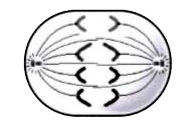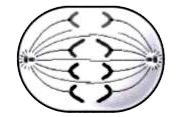Explain mitotic division with the help of diagrams.
Mitosis is known as equational division because both daughter cells have the same number and type of chromosomes as are present in mother cell.
Process of mitosis : Mitosis occurs both in somatic cells and.germ cells of the gonads. In plants, mitosis occurs in the meristematic cells.
(I) Karyokinesis or nuclear division. (II) Cytokinesis or cytoplasmic division.
(i) Karyokinesis : It is also called nuclear division. It consists of four phases:
(i) Prophase : It is the first phase of mitotic division. In this phase, chromatin fibres condense to form chromosomes. Prophase has three subphases-early, middle and late.
a) Early Prophase : Following events occur in early prophase :
1. The dividing cell becomes spherical shaped with more viscous cytoplasm.
2. Centriole pairs start moving towards the opposite poles.
3. Each centriole pair develops fine, radiating microtubules, called aster rays. These aster rays form a star shaped body, called aster.
4. Condensation of chromatin into long thread like chromosomes takes place. Each chromosome consists of two chromatids joined at centromeres.
b) Mid Prophase: It involves the following events:
1. More condensation of chromosomes to become shorter and thicker.
2. Movements of two asters due to elongation of the microtubules.
3. Nucleolus and nuclear membrane start disappearing.
c) Late Prophase : It is characterized by the following events :
1. Nearly complete disappearance of nucleolus and nuclear membrane.
2. More condensation of chromosomes.
3. Formation of spindle from two types of spindle fibres.
ii) Metaphase : It involves the following events:
a) Chromosomes arrange themselves at equator in one equatorial or metaphase plate. The smaller chromosomes present near the centre of the equator, while larger chromosomes are peripheral in position.
b) Each centromere is joined by two chromosomal fibres, one from each pole.
c) Each centromere is present at equator while its arms are directed towards the poles.
iii) Anaphase : It is characterized by the following changes :
a) Spliting of each centromere to form two daughter chromosomes.Each daughter chromosome is formed of only one chromatid.
b) Daughter chromosomes move towards opposite poles. "They may be V-shaped, J-Shaped or I-Shaped. Anaphase divides the nuclear matter into two equal and similar halves.
iv) Telophase : It involves the following changes.
a) New nuclear membrane is formed at each pole of cell. It surrounds the chromosome of pole.
b) Formation of nucleolus from NOR (Nucleolar organising region).
c) Chromosomes undergo decondensation to form nuclear chromatin.
II) Cytokinesis: It involves the division of cytoplasm.
i) In animals cells: At metaphase, cell organelles like mitochondria arrange themselves equally on either side of equator. During anaphase, a ring of dense material, the midbody is developed at the middle of spindle. After this, cell membrane develops a constrictions, called cell furrow. In telophase, cell furrow deepens towards centre and divides the cell into two daughter cells. This type of cytokinesis is called furrowing or cleavage.


Similar Questions
Explain the mitotic cell division with the help of a series of labelled diagrams.
View SolutionExplain meiosis with the help of labelled diagrams.
View SolutionExplain biofuel production with the help of a diagram
View SolutionExplain anisotropy in solids with the help of a diagram.
View SolutionWhat is transcription. Explain it with the help of a diagram.
View SolutionGiven below is a diagram representing a stage during the mitotic cell division। Study the diagram and answer the following questions :

Identify the stage by giving a suitable reason.
View SolutionGiven below is a diagram representing a stage during the mitotic cell division। Study the diagram and answer the following questions :

Name the four nitrogenous bases.
View SolutionGiven below is a diagram representing a stage during the mitotic cell division। Study the diagram and answer the following questions :

How many chromosomes will each daughter cell have after the completion of the above division ?
View SolutionExplain 'saving function' with the help of a schedule and diagram.
View SolutionExplain saving function with the help of a schedule and diagram.
View Solution
